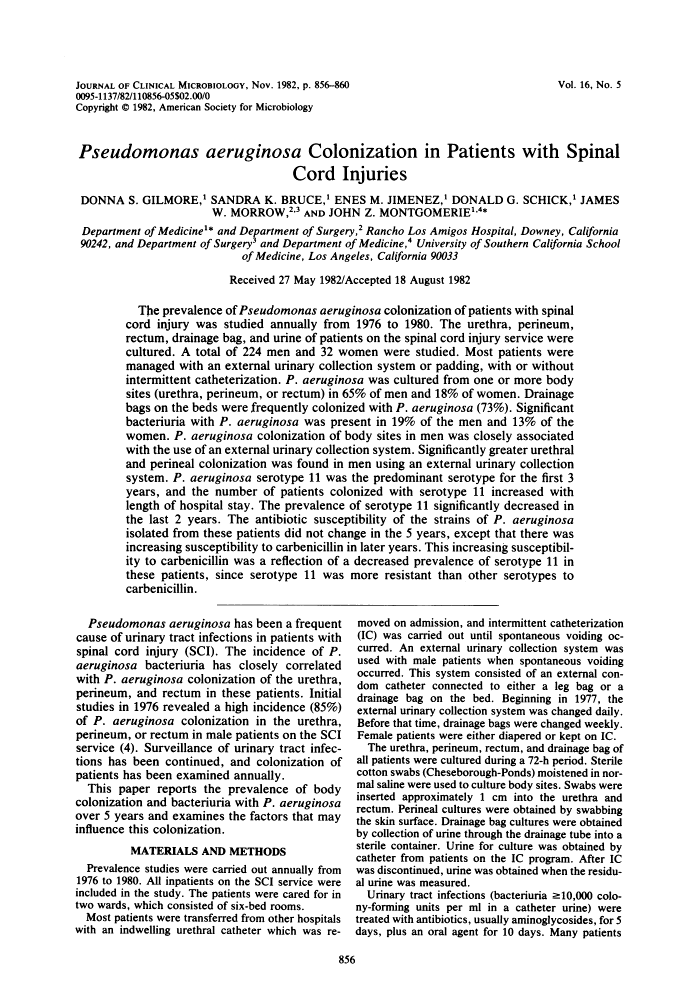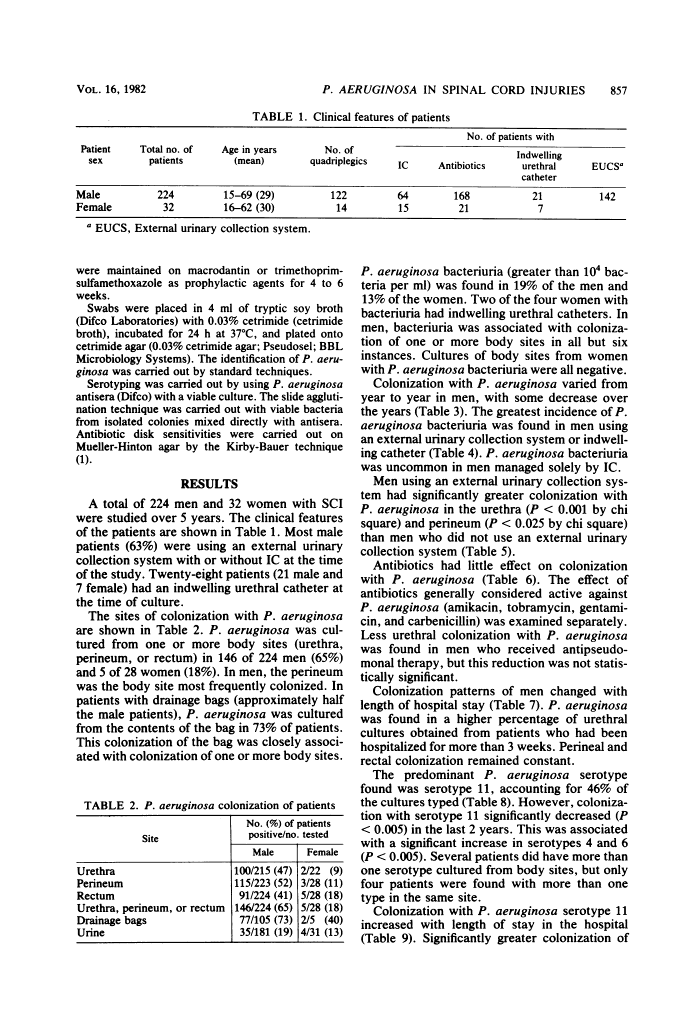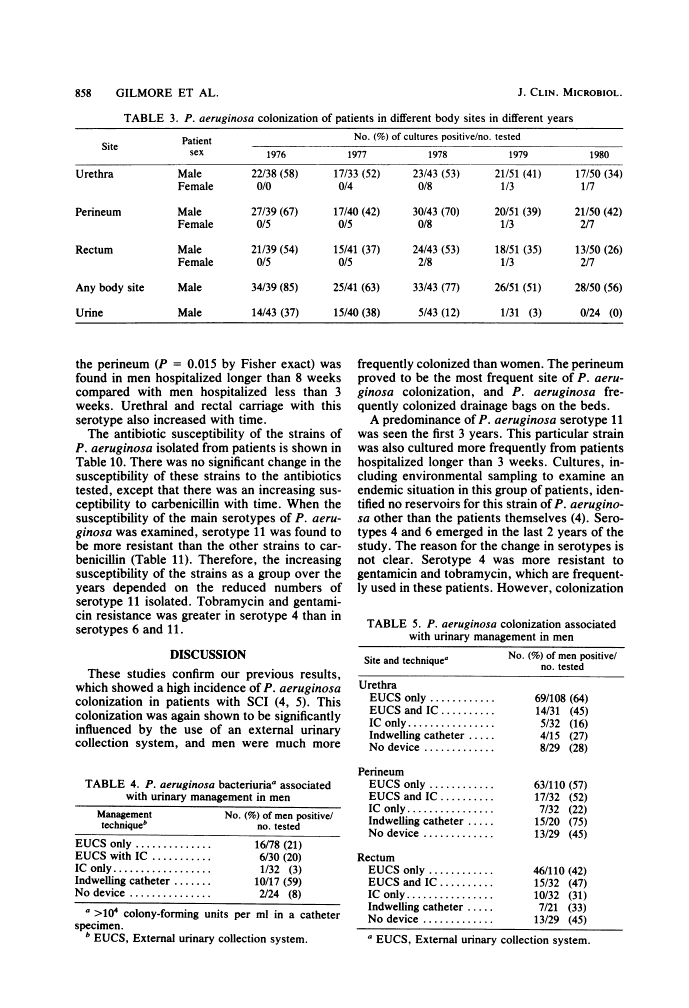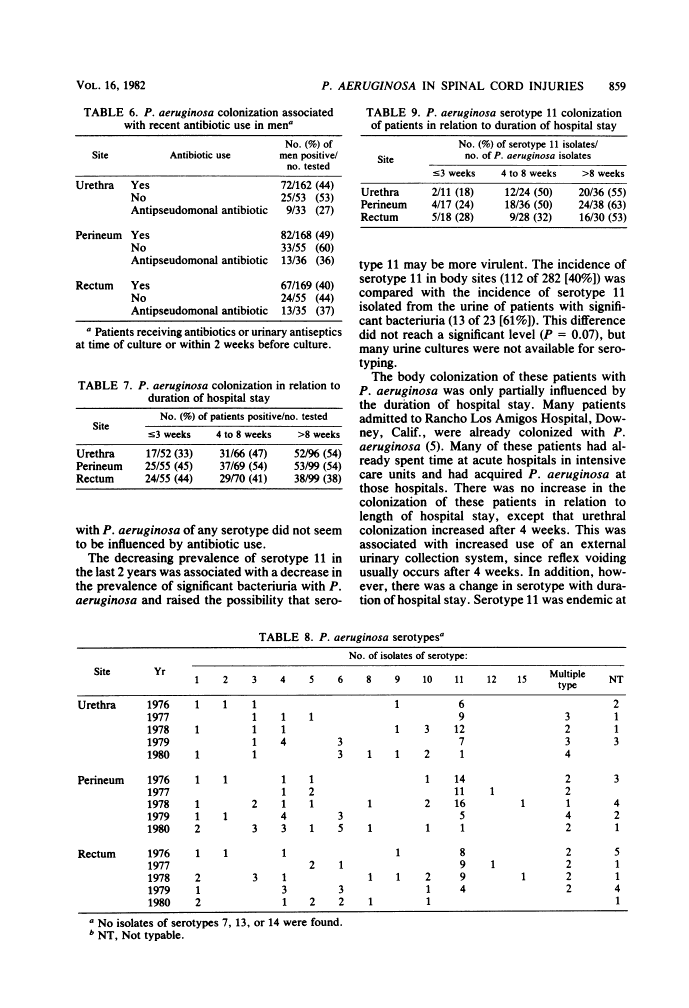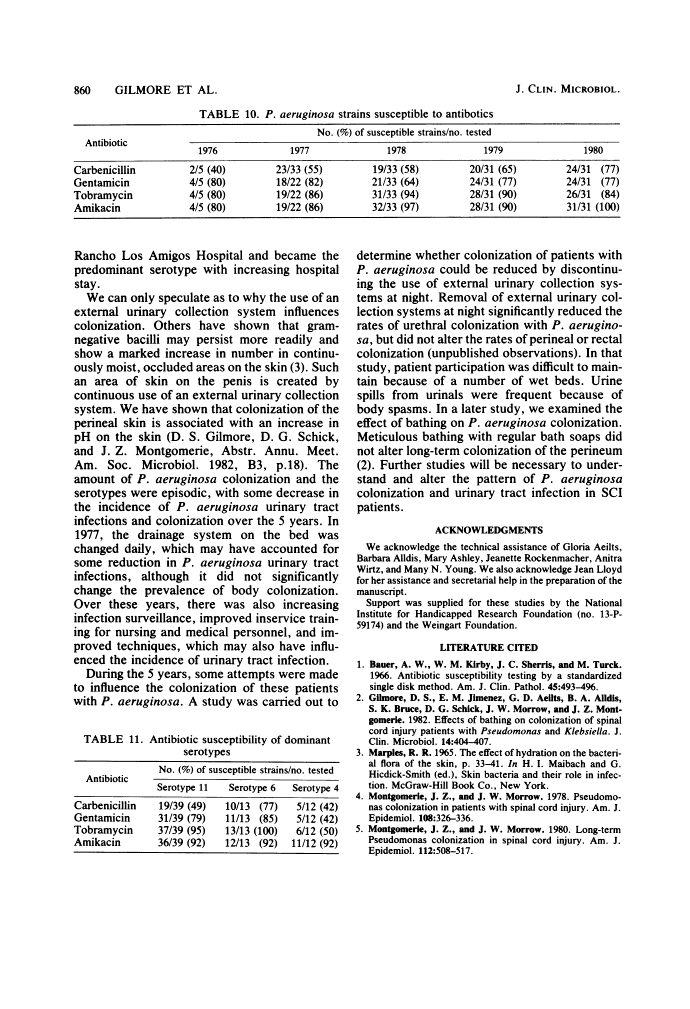Abstract
Free full text

Pseudomonas aeruginosa colonization in patients with spinal cord injuries.
Abstract
The prevalence of Pseudomonas aeruginosa colonization of patients with spinal cord injury was studied annually from 1976 to 1980. The urethra, perineum, rectum, drainage bag, and urine of patients on the spinal cord injury service were cultured. A total of 224 men and 32 women were studied. Most patients were managed with an external urinary collection system or padding, with or without intermittent catheterization. P. aeruginosa was cultured from one or more body sites (urethra, perineum, or rectum) in 65% of men and 18% of women. Drainage bags on the beds were frequently colonized with P. aeruginosa (73%). Significant bacteriuria with P. aeruginosa was present in 19% of the men and 13% of the women. P. aeruginosa colonization of body sites in men was closely associated with the use of an external urinary collection system. Significantly greater urethral and perineal colonization was found in men using an external urinary collection system. P. aeruginosa serotype 11 was the predominant serotype for the first 3 years, and the number of patients colonized with serotype 11 increased with length of hospital stay. The prevalence of serotype 11 significantly decreased in the last 2 years. The antibiotic susceptibility of the strains of P. aeruginosa isolated from these patients did not change in the 5 years, except that there was increasing susceptibility to carbenicillin in later years. This increasing susceptibility to carbenicillin was a reflection of a decreased prevalence of serotype 11 in these patients, since serotype 11 was more resistant than other serotypes to carbenicillin.
Full text
Full text is available as a scanned copy of the original print version. Get a printable copy (PDF file) of the complete article (683K), or click on a page image below to browse page by page. Links to PubMed are also available for Selected References.
Selected References
These references are in PubMed. This may not be the complete list of references from this article.
- Bauer AW, Kirby WM, Sherris JC, Turck M. Antibiotic susceptibility testing by a standardized single disk method. Am J Clin Pathol. 1966 Apr;45(4):493–496. [Abstract] [Google Scholar]
- Gilmore DS, Aeilts GD, Alldis BA, Bruce SK, Jimenez EM, Schick DG, Morrow JW, Montgomerie JZ. Effects of bathing on Pseudomonas and Klebsiella colonization in patients with spinal cord injuries. J Clin Microbiol. 1981 Oct;14(4):404–407. [Europe PMC free article] [Abstract] [Google Scholar]
- Montgomerie JZ, Morrow JW. Pseudomonas colonization in patients with spinal cord injury. Am J Epidemiol. 1978 Oct;108(4):328–336. [Abstract] [Google Scholar]
- Montgomerie JZ, Morrow JW. Long-term Pseudomonas colonization in spinal cord injury patients. Am J Epidemiol. 1980 Oct;112(4):508–517. [Abstract] [Google Scholar]
Associated Data
Articles from Journal of Clinical Microbiology are provided here courtesy of American Society for Microbiology (ASM)
Full text links
Read article at publisher's site: https://doi.org/10.1128/jcm.16.5.856-860.1982
Read article for free, from open access legal sources, via Unpaywall:
https://jcm.asm.org/content/jcm/16/5/856.full.pdf
Free after 4 months at intl-jcm.asm.org
http://intl-jcm.asm.org/cgi/reprint/16/5/856.pdf
Free to read at intl-jcm.asm.org
http://intl-jcm.asm.org/cgi/content/abstract/16/5/856
Citations & impact
Impact metrics
Citations of article over time
Smart citations by scite.ai
Explore citation contexts and check if this article has been
supported or disputed.
https://scite.ai/reports/10.1128/jcm.16.5.856-860.1982
Article citations
Bacteriology of pressure ulcers in individuals with spinal cord injury: What we know and what we should know.
J Spinal Cord Med, 38(2):147-160, 17 Aug 2014
Cited by: 28 articles | PMID: 25130374 | PMCID: PMC4397196
Review Free full text in Europe PMC
Correlation between serogroup, in vitro biofilm formation and elaboration of virulence factors by uropathogenic Pseudomonas aeruginosa.
FEMS Immunol Med Microbiol, 58(2):237-243, 28 Nov 2009
Cited by: 13 articles | PMID: 19930457
Infection of Brindley sacral anterior root stimulator by Pseudomonas aeruginosa requiring removal of the implant: long-term deleterious effects on bowel and urinary bladder function in a spinal cord injury patient with tetraplegia: a case report.
Cases J, 2:9364, 21 Dec 2009
Cited by: 4 articles | PMID: 20062610 | PMCID: PMC2804010
Acute respiratory infections in persons with spinal cord injury.
Phys Med Rehabil Clin N Am, 18(2):203-16, v-vi, 01 May 2007
Cited by: 22 articles | PMID: 17543769 | PMCID: PMC7172350
Review Free full text in Europe PMC
Management of community-acquired pneumonia in persons with spinal cord injury.
Spinal Cord, 42(8):450-458, 01 Aug 2004
Cited by: 11 articles | PMID: 15037861
Go to all (18) article citations
Similar Articles
To arrive at the top five similar articles we use a word-weighted algorithm to compare words from the Title and Abstract of each citation.
Pseudomonas colonization in patients with spinal cord injury.
Am J Epidemiol, 108(4):328-336, 01 Oct 1978
Cited by: 25 articles | PMID: 103431
Long-term Pseudomonas colonization in spinal cord injury patients.
Am J Epidemiol, 112(4):508-517, 01 Oct 1980
Cited by: 27 articles | PMID: 7424900
Klebsiella pneumoniae colonization in patients with spinal cord injury.
Diagn Microbiol Infect Dis, 7(4):229-235, 01 Aug 1987
Cited by: 8 articles | PMID: 3315404
[Evaluation of multiple Pseudomonas aeruginosa strains with different characteristics in clinical specimens; combined results from serotyping, drug susceptibility and enzyme production].
Rinsho Byori, 43(11):1135-1139, 01 Nov 1995
Cited by: 0 articles | PMID: 8551677
Review
